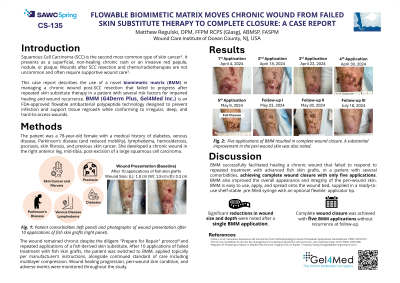Case Series/Study
(CS-135) Peptide-based Biomimetic Matrix Moves Chronic Wound from Failed Skin Substitute Therapy to Rapid Closure
Friday, May 2, 2025
7:45 PM - 8:45 PM East Coast USA Time

Introduction: Squamous Cell Carcinoma (SCC) is the second most common type of skin cancer1. It presents as a superficial, non-healing chronic rash or an invasive red papule, nodule, or plaque. Wounds after SCC resection and chemo/radiotherapies are not uncommon and often require supportive, multifaceted wound care2.This case report describes the use of a novel biomimetic matrix (BMM)* in managing a chronic wound post-SCC resection that failed to progress after repeated skin substitute therapy in a patient with several risk factors for impaired healing and wound recurrence. BMM is an FDA-approved polypeptide 3D scaffold designed to support tissue regrowth and prevent infection while providing intimate contact with the wound.
Methods: The patient was a 78-year-old female with a medical history of diabetes, venous disease, Parkinson's disease (and reduced mobility), lymphedema, psoriasis, skin fibrosis, and previous skin cancer. She developed a chronic wound in the right anterior leg, mid-tibia, post-excision of a large squamous cell carcinoma. Despite appropriate standard of care and repeated applications of a fish-derived skin substitute, the ulcer remained chronic. After 10 weeks of failed treatment with fish skin grafts, the patient was switched to BMM, applied topically per manufacturer instructions, alongside continued standard of care including multilayer compression. Wound measurements were recorded at baseline and during each visit. Wound healing progression, peri-wound skin condition, and adverse events were monitored throughout the study.
Results: Despite previous failure of fish-derived skin substitutes over 10 weeks of treatment, rapid improvement in wound healing was observed with BMM. Significant reductions in wound size and depth were noted after a single BMM application. Remarkably, complete wound closure was achieved within five BMM applications, and no recurrence was noted during the follow-up period. Moreover, peri-wound skin appearance improved substantially. No product-related adverse events were observed.
Discussion: BMM successfully facilitated healing of a chronic, non-responsive wound in a patient with numerous comorbidities, achieving complete wound closure with just five applications. These findings highlight BMM’s potential for rapid healing progression in chronic wounds unresponsive to traditional skin substitutes and advanced wound care products, which could signify a change in clinical practice. Further studies are necessary to confirm these results and determine BMM’s efficacy in a larger patient population.
Methods: The patient was a 78-year-old female with a medical history of diabetes, venous disease, Parkinson's disease (and reduced mobility), lymphedema, psoriasis, skin fibrosis, and previous skin cancer. She developed a chronic wound in the right anterior leg, mid-tibia, post-excision of a large squamous cell carcinoma. Despite appropriate standard of care and repeated applications of a fish-derived skin substitute, the ulcer remained chronic. After 10 weeks of failed treatment with fish skin grafts, the patient was switched to BMM, applied topically per manufacturer instructions, alongside continued standard of care including multilayer compression. Wound measurements were recorded at baseline and during each visit. Wound healing progression, peri-wound skin condition, and adverse events were monitored throughout the study.
Results: Despite previous failure of fish-derived skin substitutes over 10 weeks of treatment, rapid improvement in wound healing was observed with BMM. Significant reductions in wound size and depth were noted after a single BMM application. Remarkably, complete wound closure was achieved within five BMM applications, and no recurrence was noted during the follow-up period. Moreover, peri-wound skin appearance improved substantially. No product-related adverse events were observed.
Discussion: BMM successfully facilitated healing of a chronic, non-responsive wound in a patient with numerous comorbidities, achieving complete wound closure with just five applications. These findings highlight BMM’s potential for rapid healing progression in chronic wounds unresponsive to traditional skin substitutes and advanced wound care products, which could signify a change in clinical practice. Further studies are necessary to confirm these results and determine BMM’s efficacy in a larger patient population.

.jpg)